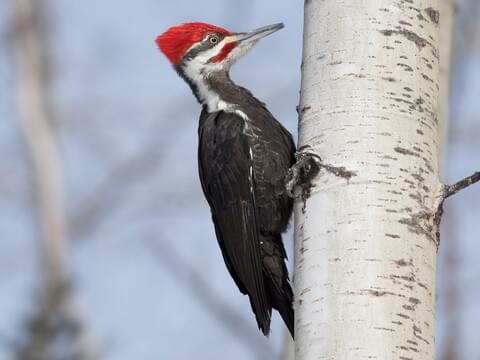Experiencing Woodpeckers in Florida: Variety Variety and Identification
Wiki Article
Woodpeckers Unleashed: Discovering the Marvels of These Experienced Tree Mountain Climbers
Woodpeckers, with their distinctive markings and rhythmic drumming resembling via wooded areas, hold a special location in the avian world. Their specialized makeup and adaptations enable them to navigate upright surfaces with exceptional skill. Their mastery of tree climbing is just one facet of their interesting habits. As we explore the elaborate information of woodpeckers' nesting routines, feeding techniques, and the continuous conservation initiatives to protect these amazing birds, a much deeper recognition for their location in nature unfolds.Makeup and Adaptations
When checking out the composition and adjustments of woodpeckers, one can observe impressive attributes that allow these birds to grow in their specialized eco-friendly niche. In addition, woodpeckers have zygodactyl feet, with 2 toes facing onward and two dealing with backward, providing a company hold on tree trunks while they browse for food or drum for communication.In addition, woodpeckers have a special tongue framework that is long, barbed, and sticky, enabling them to remove insects from gaps in wood. This specific adjustment allows woodpeckers to manipulate a food resource that is inaccessible to numerous various other bird types. In general, the composition and adjustments of woodpeckers display the impressive transformative solutions that have actually permitted these birds to thrive in their arboreal habitat.
Drumming Habits
Having actually discovered the anatomy and adjustments of woodpeckers, the emphasis currently changes to understanding their drumming behavior, a distinctive facet of their interaction and territorial display screens. Drumming is a vital type of interaction among woodpeckers, offering several purposes such as establishing areas, attracting friends, and signaling alarm system. Each woodpecker types has a distinct drumming pattern that assists individuals recognize participants of their very own species and distinguish them from rivals or killers.Woodpeckers generate drumming audios by rapidly pecking on powerful surface areas such as dead trees, utility posts, and even metal items, developing a collection of rhythmic beats. The intensity and rate of drumming can differ based upon the objective; for example, a rapid drumming series might indicate aggression towards trespassers, while a slower and softer drumming pattern can suggest courtship (Woodpeckers in Florida). Furthermore, woodpeckers might readjust the frequency and duration of their drumming to communicate details messages properly
Nesting Habits
Checking out the nesting practices of woodpeckers reveals fascinating understandings into their reproductive habits and habitat selections. Woodpeckers are recognized for their one-of-a-kind nesting choices, frequently digging deep into dental caries in trees to produce protected spaces for raising their young. These tooth cavities offer not only as a nesting website however likewise as a protected refuge from killers and stormy climate.Woodpeckers exhibit a high degree of integrity to their nesting websites, often going back to the very same place every year. This actions highlights the importance of ideal habitat accessibility for their reproductive success. The choice of a nesting website is essential for woodpeckers, with elements see post such as tree types, height, and degeneration phase playing substantial functions in their decision-making procedure.
Surprisingly, some woodpecker species are understood to excavate numerous cavities within their region, providing themselves with different nesting options. This technique may act as a form of insurance policy versus prospective hazards or disturbances to their primary nesting site.

Feeding Strategies
Woodpeckers utilize a variety of specialized feeding methods to obtain their key food sources. One of the most distinct feeding actions of woodpeckers is drumming, which involves quick pecking on trees to uncover bugs below the bark. This drumming not only aids them find prey but likewise functions as a method of communication with other woodpeckers. Woodpeckers have solid, chisel-like beaks that allow them to pierce into wood effortlessly. Once a hole is produced, they use their long, barbed tongues to draw out bugs such as ants, beetles, larvae, and spiders. These tongues are coated with sticky saliva that helps trap the target. Woodpeckers are likewise understood to dig deep into dental caries in trees to gain access to hidden insect larvae or sap. Some varieties, like the acorn woodpecker, shop nuts in particularly developed openings called granaries. This useful site critical saving of food assists them endure during food scarcity periods. Woodpeckers are genuinely amazing in their feeding techniques, showcasing flexibility and knowledge in acquiring their nourishment.Preservation Efforts
Amidst the intricate feeding methods exhibited by woodpeckers, the conservation efforts intended at securing these fascinating birds play an essential role in maintaining their environments and populaces. Woodpeckers encounter different risks to their survival, consisting of environment loss due to deforestation, environment change modifying their ecosystems, and accidents with manufactured frameworks such as buildings and automobiles - Woodpeckers in Florida. Preservationists are proactively functioning to deal with these difficulties and make sure the long-lasting health of woodpecker species
Education and learning and public understanding projects are likewise vital components of woodpecker preservation efforts. By increasing awareness regarding the significance of these birds in preserving healthy and balanced forest communities, conservationists can amass support for habitat conservation efforts and promote accountable land management practices. Through collaborative initiatives in between researchers, policymakers, and regional areas, we can collaborate to protect a future where woodpeckers prosper in their all-natural habitats.
Final Thought

Report this wiki page